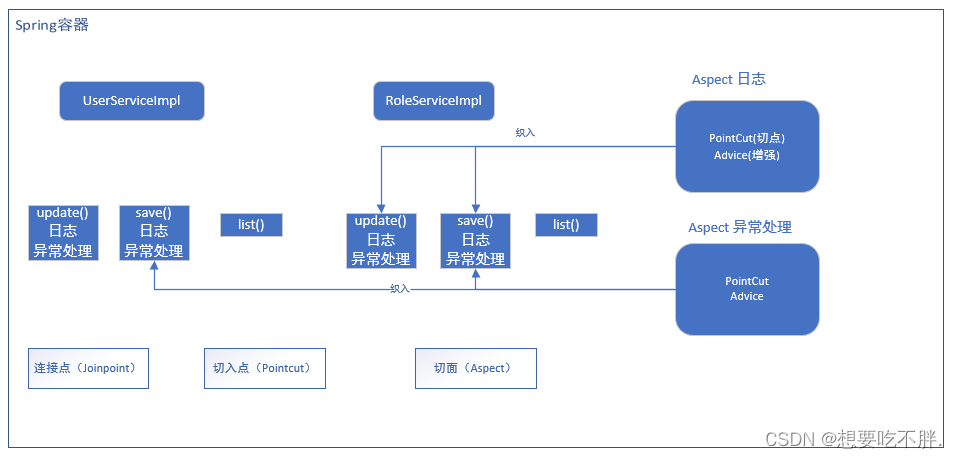目录
1、AOP
2、AOP底层原理
3、AOP准备工作
4、AspectJ 注解实现
5、AspectJ 配置文件实现
一、AOP

怎么解决日志、异常处理等公共问题?
AOP 概述
-
定义:AOP(Aspect Oriented Programming,面向切面编程),通过预编译和运行时动态代理扩展程序功能。
-
作用:利用 AOP 可以对业务逻辑的各个部分进行隔离,降低耦合性,提高程序可重用性和开发效率
-
场景:日志记录,性能统计,安全控制,事务处理,异常处理
-
通俗描述:不修改源代码,在主干功能中添加新功能
AOP 术语
-
连接点(Joinpoint): 程序执行过程中明确的点,如方法的调用,或者异常的抛出。在Spring AOP中,连接点总是方法的调用。
-
切入点(Pointcut): 可以插入增强处理的连接点。简而言之,当某个连接点满足指定要求时,该连接点将被添加增强处理,该连接点也就变成了切入点。
-
切面(Aspect): 切面用于组织多个Advice,Advice放在切面中定义:某方面切点集合;例如:事务,日志,安全,异常等
-
增强(通知,装置)(Advice):
-
AOP框架在特定的切入点执行的增强处理。
-
实际增强的逻辑部分,称为通知,通知分为五种类型:
-
前置通知:方法执行之前的处理
-
返回通知:方法执行之后的处理
-
环绕通知:方法执行前后的处理
-
异常通知:方法抛出异常的处理
-
后置通知:方法执行之后一定的处理
-
-
-
织入:是一个动作,即把通知应用到切入点的过程
二、AOP 底层原理(扩展)
-
底层原理:动态代理
-
有接口情况:JDK动态代理
-
无接口情况:CGLib动态代理
-
如果学习过设计模式,应该对上述两种代理方式非常了解了。没有学习过也没关系,我们接着往下看
JDK 动态代理
public interface UserDao {
void save();
}
public class UserDaoImpl implements UserDao {
@Override
public void save(){
//保存
}
}有接口情况:创建 UserDao 接口实现类代理对象
CGlib 动态代理
public class User {
public void add(){
//...
}
}
// 原始方法:通过子类继承,重写User类方法
public class Person extends User {
@Override
public void add(){
super.add();
//增强代码逻辑
}
}无接口情况:创建 User 类子类代理对象
由于 Spring5 中对上述代理已经做了很好的封装,我们只需要通过最简单的方式进行配置即可
但仍然需要我们对原理有一定的认识,只有做到“知其然,知其所以然”,才能真正“以不变应万变”
JDK静态代理实现
public class StaticUserDaoProxy implements UserDao {
private UserDao userDao = null;
public StaticUserDaoProxy(UserDao userDao){
this.userDao = userDao;
}
@Override
public void save() {
System.out.println("开启事务");
//调用代理目标类的方法
userDao.save();
System.out.println("提交事务");
}
}JDK 动态代理实现
实现方式:使用Proxy中的方法创建代理对象
具体方法:newProxyInstance()
方法参数
-
ClassLoader loader:类加载器 -
Class<?>[] interfaces:增强方法所在类实现的接口数组 -
InvocationHandler h:实现InvocationHandler接口,创建代理对象,编写增强方法
常言道:“Talking is cheap, show me the code"。话不多说,下面上代码~
-
1)创建 UserDao 接口和对应实现类
public interface UserDao {
int add(int a, int b);
String update(String id);
}
public class UserDaoImpl implements UserDao {
@Override
public int add(int a, int b) {
return a + b;
}
@Override
public String update(String id) {
return id;
}
}-
2)创建 UserDao 代理对象
public class UserDaoProxy {
private UserDao target;
public UserDaoProxy(UserDao target) {
this.target = target;
}
public UserDao newProxyInstance() {
Class<?> targetClass = target.getClass();
ClassLoader classLoader = targetClass.getClassLoader();
Class<?>[] interfaces = targetClass.getInterfaces();
return (UserDao) Proxy.newProxyInstance(classLoader, interfaces, new UserDaoInvocationHandler());
}
class UserDaoInvocationHandler implements InvocationHandler {
@Override
public Object invoke(Object proxy, Method method, Object[] args) throws Throwable {
// 被代理对象方法前置逻辑
System.out.print("method=" + method.getName() + ", args=" + Arrays.toString(args));
// 被代理对象方法
Object result = method.invoke(target, args);
// 被代理对象方法后置逻辑
System.out.println(", result=" + result);
return result;
}
}
}-
3)测试
UserDao target = new UserDaoImpl();
UserDaoProxy userDaoProxy = new UserDaoProxy(target);
UserDao userDao = userDaoProxy.newProxyInstance();
userDao.add(1, 2);
userDao.update("UUID1");
// method=add, args=[1, 2], result=3
// method=update, args=[UUID1], result=UUID1三、AOP 准备工作
AspectJ 介绍
Spring 一般都是基于AspectJ实现 AOP 操作的
-
AspectJ不是 Spring 的一部分,而是一个独立的 AOP 框架 -
一般会把
AspectJ和 Spring 搭配使用,进行 AOP 操作,因为这样更加方便
基于 AspectJ 进行 AOP 操作的两种方式:
-
基于 XML 配置文件方式实现
-
基于注解方式实现(推荐使用)
引入 AOP 相关依赖
<dependency> <groupId>org.springframework</groupId> <artifactId>spring-aspects</artifactId> </dependency>
切入点表达式
切入点表达式的作用:知道对哪个类的哪个方法进行增强
语法结构:execution([权限修饰符][返回类型][类全路径][方法名]([参数列表]))
四、AspectJ 注解实现
Spring 配置文件
-
1)引入
context和aop名称空间 -
2)配置组件扫描基础包
-
3)开启AspectJ生成代理对象
<?xml version="1.0" encoding="UTF-8"?>
<beans xmlns="http://www.springframework.org/schema/beans"
xmlns:context="http://www.springframework.org/schema/context"
xmlns:aop="http://www.springframework.org/schema/aop"
xmlns:xsi="http://www.w3.org/2001/XMLSchema-instance"
xsi:schemaLocation="http://www.springframework.org/schema/beans http://www.springframework.org/schema/beans/spring-beans.xsd
http://www.springframework.org/schema/context http://www.springframework.org/schema/context/spring-context.xsd
http://www.springframework.org/schema/aop http://www.springframework.org/schema/aop/spring-aop.xsd">
<!--组件扫描配置-->
<context:component-scan base-package="com.zking.spring"/>
<!--开启AspectJ生成代理对象-->
<aop:aspectj-autoproxy/>
</beans>创建被增强对象和增强对象
-
1)创建 UserService对象,并添加
@Service注解 -
2)创建 LogAspect对象,并添加
@Component注解
@Service
public class BookServiceImpl implements BookService {
@Override
public void update() {
System.out.println("book update...");
}
@Override
public void save() {
System.out.println("book save...");
}
@Override
public void list() {
System.out.println("book list...");
}
}
@Component
public class LogAspect {
/**
* 前置通知
*/
public void before() {
System.out.println("before...");
}
/**
* 返回通知
*/
public void afterReturning() {
System.out.println("afterReturning...");
}
/**
* 后置通知
*/
public void after() {
System.out.println("after...");
}
/**
* 异常通知
*/
public void afterThrowing() {
System.out.println("afterThrowing...");
}
/**
* 环绕通知
*/
public void around() {
System.out.println("around...");
}
}
完全注解开发
如果要用完全注解的方式进行开发,可以使用注解类代替 Spring 配置文件
@Configuration
@ComponentScan(value = "com.zking.spring")
@EnableAspectJAutoProxy(proxyTargetClass = true)
public class AopConfig {
}
其中:
-
注解
@ComponentScan(value = "com.zking.spring")代替了<context:component-scan base-package="com.zking.spring"/>进行组件扫描的配置 -
注解
@EnableAspectJAutoProxy(proxyTargetClass = true)代替了<aop:aspectj-autoproxy/>开启AspectJ生成代理对象
对应关系
| 注解方式 | 配置文件方式 |
|---|---|
@ComponentScan | <context:component-scan> |
@EnableAspectJAutoProxy | <aop:aspectj-autoproxy> |
五、AspectJ 配置文件实现
创建被增强对象和增强对象
与3.6.2相同,并可去掉注解
Spring 配置文件
-
1)引入
aop名称空间 -
2)配置被增强对象和增强对象创建
-
3)配置
aop增强
<?xml version="1.0" encoding="UTF-8"?>
<beans xmlns="http://www.springframework.org/schema/beans"
xmlns:xsi="http://www.w3.org/2001/XMLSchema-instance" xmlns:aop="http://www.springframework.org/schema/aop"
xsi:schemaLocation="http://www.springframework.org/schema/beans http://www.springframework.org/schema/beans/spring-beans.xsd http://www.springframework.org/schema/aop https://www.springframework.org/schema/aop/spring-aop.xsd">
<!--创建对象-->
<bean id="userService" class="com.zking.spring.service.impl.UserService"></bean>
<bean id="logAspect" class="com.zking.spring.aspect.LogAspect"></bean>
<!--配置aop增强-->
<aop:config>
<!--配置切入点-->
<aop:pointcut id="p" expression="execution(* com.zking.spring.service..*.*(..))"/>
<!--配置切面-->
<aop:aspect ref="logAspect">
<!--前置通知-->
<aop:before method="before" pointcut-ref="p"/>
<!--后置通知-->
<aop:after-returning method="afterReturning" pointcut-ref="p"/>
<!--最终通知-->
<aop:after method="after" pointcut-ref="p"/>
<!--异常通知-->
<aop:after-throwing method="afterThrowing" pointcut-ref="p"/>
<!--环绕通知-->
<aop:around method="around" pointcut-ref="p"/>
</aop:aspect>
</aop:config>
</beans>其中,配置文件的标签与注解的对应关系如下表
| 配置文件方式 | 注解方式 |
|---|---|
<aop:pointcut> | @Pointcut |
<aop:aspect> | @Aspect |
<aop:before> | @Before |
<aop:after-returning> | @AfterReturning |
<aop:after> | @After |
<aop:after-throwing> | @AfterThrowing |
<aop:around> | @Around |
代码测试
ApplicationContext ctx = new ClassPathXmlApplicationContext("beans2.xml");
BookService bookService = ctx.getBean("bookServiceImpl", BookService.class);
bookService.update();测试结果
before.... around before.... book update... around after.... after.... AfterReturning....






















 1万+
1万+











 被折叠的 条评论
为什么被折叠?
被折叠的 条评论
为什么被折叠?








